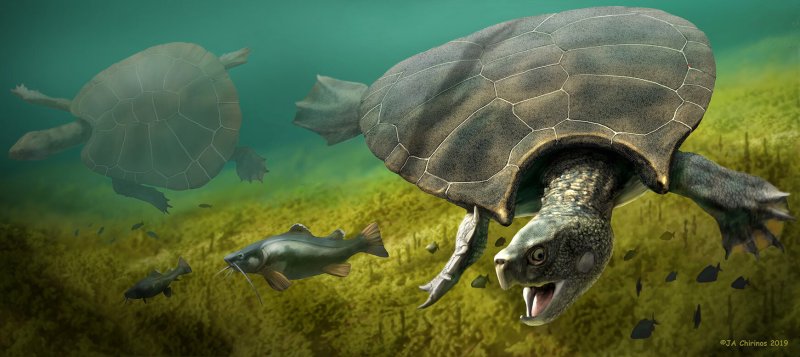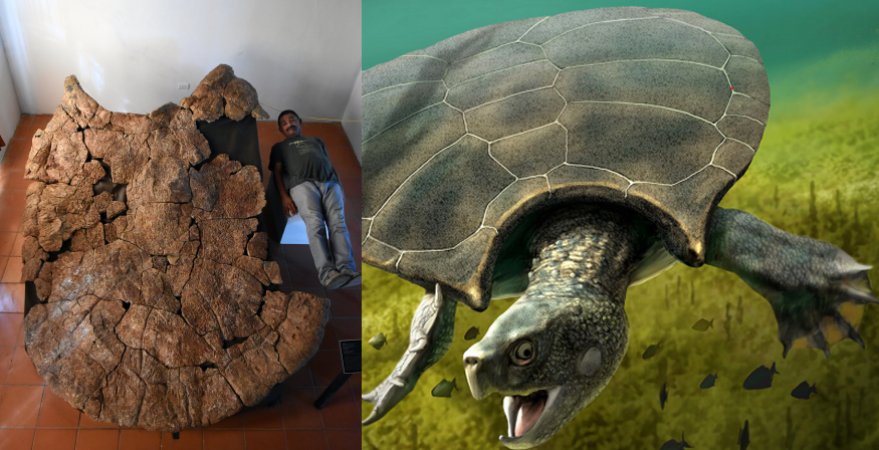Don Wood – MessageToEagle.com – Many ancient animals were much larger than they are today, but this turtle is unique.
Its name is Stupendemys and it may be the world’s largest turtle. Specimens of this extinct giant freshwater turtle were found in Venezuela and Colombia.

A graphic reconstruction of the giant turtle Stupendemys geographicus: male (front) and female individual (left) swimming in freshwater. Credit: Artwork: Jaime Chirinos
The turtle measured between 2.4 to almost 3 meters and the shell of male Stupendemys had horns, which is a rare feature in turtles. The turtle had an estimated body mass of 1,145 kg—almost one hundred times that of its closest living relative, the big-headed Amazon river turtle.
Despite its tremendous size, the turtle had natural enemies. In many areas, the occurrence of Stupendemys coincides with Purussaurus, the largest caimans.
This was most likely a predator of the giant turtle, given not only its size and dietary preferences, but also as inferred by bite marks and punctured bones in fossil carapaces of Stupendemys.
Scientists from the University of Zurich (UZH) and fellow researchers from Colombia, Venezuela, and Brazil have now reported exceptional specimens of the extinct turtle recently found in new locations across Venezuela and Colombia.
See also:
Goliath Birdeater: World’s Largest Spider Can Grow As Long As A Child’s Forearm
Giant Flying Reptile Of The North – Cryodrakon Boreas Was One Of The Largest Ever Flying Animals
Legendary Giant Squid’s Genome Revealed – Why Is It So Scarily Big?
World’s Largest’ Flower – Giant Rafflesia Tuan-Mudae Spotted In Indonesia
Researchers also discovered jaws and other skeleton parts of Stupendemys. This finding gave them the possibility to thoroughly revise the evolutionary relationships of this species within the turtle tree of life.
“Based on studies of the turtle anatomy, we now know that some living turtles from the Amazon region are the closest living relatives,” says Marcelo Sánchez, director of the Paleontological Institute and Museum of UZH and head of the study.
“The carapace of some Stupendemys individuals reached almost three meters, making it one of the largest, if not the largest turtle that ever existed,” Sánchez added.
Venezuelan Palaeontologist Rodolfo Sánchez and a male carapace of the giant turtle Stupendemys geographicus, from Urumaco, Venezuela, found in 8 million years old deposits. Credit: Edwin Cadena
In some individuals, the complete carapace showed a peculiar and unexpected feature: horns.
“The two shell types indicate that two sexes of Stupendemys existed—males with horned shells, and females with hornless shells,” concludes Sánchez.
According to the paleobiologist, this is the first time that sexual dimorphism in the form of horned shells has been reported for any of the side-necked turtles, one of the two major groups of turtles world-wide.
The tropical region of South America is one of the world’s hot spots when it comes to animal diversity.
The region’s extinct fauna is unique, as documented by fossils of giant rodents and crocodilians, including crocodiles, alligators, caimans, and gavials—that inhabited what is today a desert area in Venezuela.
Five to ten million years ago, this was a humid swampy region teeming with life, and one was the giant horned turtle Stupendemys geographicus.
Written by Don Wood – MessageToEagle.com Staff







